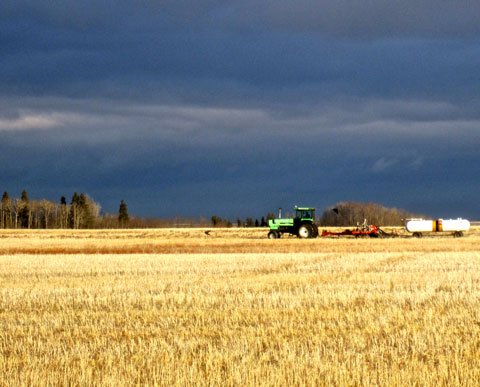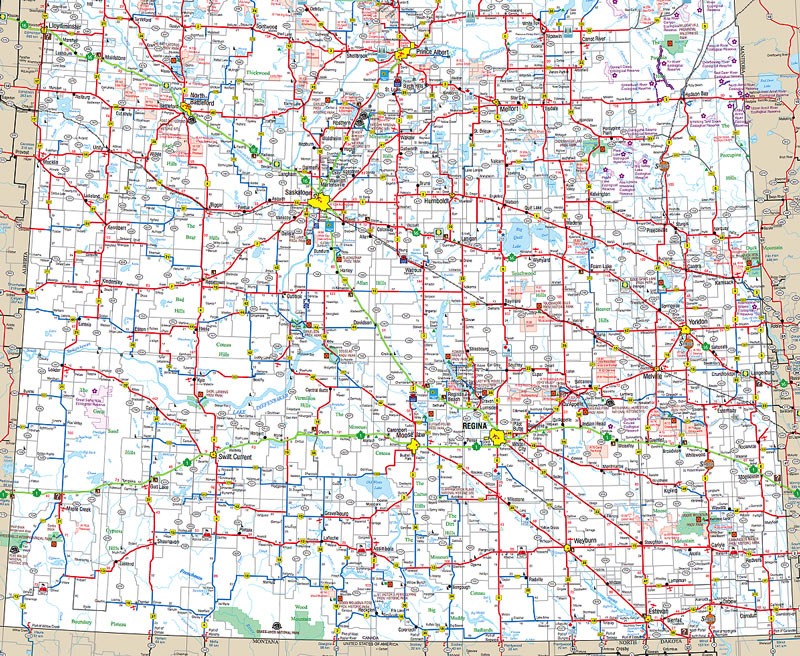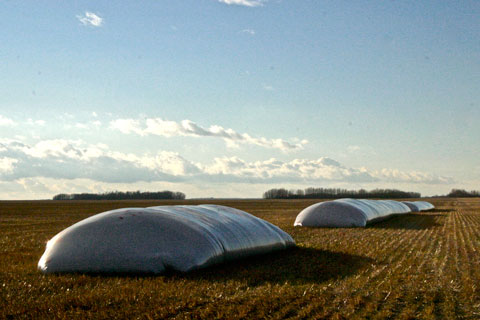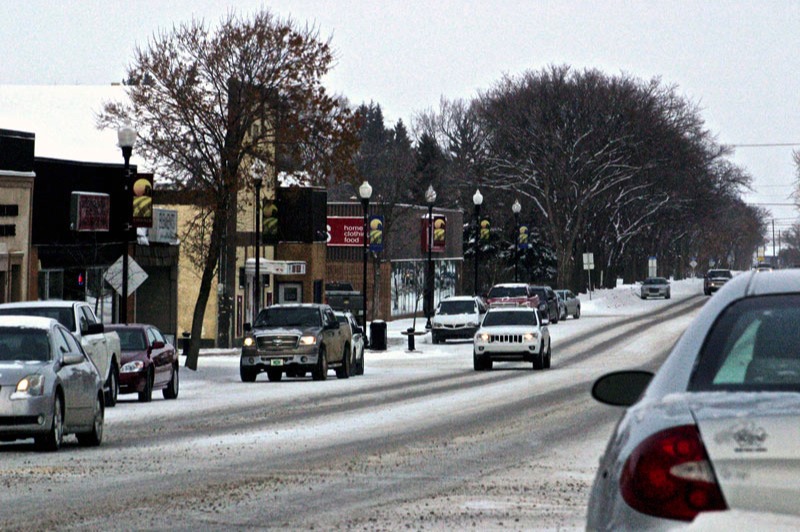
Quarterback Darren Durant lifts the Grey Cup victoriously over his head yesterday in Mosaic Stadium. Image by Ken Jones
Utopia or not to utopia
Tisdale, November 25, 2013
by Timothy W. Shire
Tisdale, November 25, 2013
by Timothy W. Shire
I think I was in grade six when Wayne Wallace, a grade seven guy who had been hit by a car while riding his bicycle and boned up on football as he lay in casts in hospital for what seemed a lifetime for him, explained to me, Billy Brown and Jim Cairns the finer points of football during lunch hour, not soccer, but Canadian football. What was a first down, a field goal, touch down and from then on, I could make sense out of the play by play on CKCK, Regina's main radio station. That fall, four key players on the team were killed in the crash of CP flight #810, when it struck a mountain. The memory of that tragedy is still clear in my mind today.
In 1956 Saskatchewan had a small population, our big places in my part of the province were Wawota, Kipling, Whitewood and Moosomin, where I was born. Our little village, Langbank had only about 86 people, but we lived in a civilised world, with daily passenger train service, which also brought us mail, food and our purchases from Eaton's and Sinpson's Sears. In my mind, life was good.
In the rest of Canada, the very presence of the Saskatchewan Roughriders was almost an insult to the CFL, it was joke among broadcasters and the print media, claiming that the market was to small to support a professional sports team. That claim was nothing new, it had been the case since the team was put together in September of 1910 (team history) and the winning for three championships, the Grey Cup, did not really legitimise the team. Despite the fact that the fan base for the team had grown to include just about everyone in the whole province. Yesterday, fourth win of the Grey Cup has etched in snow, ice and stone, the determination of this province to have the best damn football team in the country, with fans by the legion, in every city the league has franchises.
For one hundred and three years, the Riders have struggled to become Canada's number one sports franchise and they have done that as a community owned and managed organisation. The president of the club and CEO, Jim Hopson was an offensive guard with the Regina Rams and launched his career with the team in 1973, the same year he began his teaching career in Ceylon Saskatchewan as a grade three teacher. I remember his devotion to his students as he excelled in teaching reading and the image of this friendly giant and his tiny students, is one of my cherished memories of what education is all about.
Ask anyone you like and you will discover, that the most significant factor in determining who a person sees themselves to be and it is where they are from. We are where we come from, because so much of what we are is embodied in that environment. The Wayne Wallaces, Billy Browns and Jim Hopsons of our world make our world what it is and they in turn are the components of the whole concept of place.
In 1956 Saskatchewan had a small population, our big places in my part of the province were Wawota, Kipling, Whitewood and Moosomin, where I was born. Our little village, Langbank had only about 86 people, but we lived in a civilised world, with daily passenger train service, which also brought us mail, food and our purchases from Eaton's and Sinpson's Sears. In my mind, life was good.
In the rest of Canada, the very presence of the Saskatchewan Roughriders was almost an insult to the CFL, it was joke among broadcasters and the print media, claiming that the market was to small to support a professional sports team. That claim was nothing new, it had been the case since the team was put together in September of 1910 (team history) and the winning for three championships, the Grey Cup, did not really legitimise the team. Despite the fact that the fan base for the team had grown to include just about everyone in the whole province. Yesterday, fourth win of the Grey Cup has etched in snow, ice and stone, the determination of this province to have the best damn football team in the country, with fans by the legion, in every city the league has franchises.
For one hundred and three years, the Riders have struggled to become Canada's number one sports franchise and they have done that as a community owned and managed organisation. The president of the club and CEO, Jim Hopson was an offensive guard with the Regina Rams and launched his career with the team in 1973, the same year he began his teaching career in Ceylon Saskatchewan as a grade three teacher. I remember his devotion to his students as he excelled in teaching reading and the image of this friendly giant and his tiny students, is one of my cherished memories of what education is all about.
Ask anyone you like and you will discover, that the most significant factor in determining who a person sees themselves to be and it is where they are from. We are where we come from, because so much of what we are is embodied in that environment. The Wayne Wallaces, Billy Browns and Jim Hopsons of our world make our world what it is and they in turn are the components of the whole concept of place.
.

Through out our history in this province we have seen this theme come up time and time again and unlike the Riders, we have not been successful in stemming the tide of organisational bigness.
In our education system we saw in the 1950s the development of the "greater school units" which preserved the local establishment of school board control, but in the 1990s came the province's education divisions which pretty much wiped out local control of schools and in terms of financial success, was a complete and total flop. With the huge school divisions, came financial experts into education, bulging the administrative payroll with more office jockeys and meritless school closures, which in almost all cases, cost far more than any money saved.
But the stupidity did not end there. Twice in an attempt to curb health care spending, the provincial government crushed the local hospital board system, with health regions then even bigger health regions. I know of no one who sees any improvement in the delivery of health care, nor is there any evidence that even one shiny dime has been saved by the imposition of more control over the delivery of services by so-called financial experts.
.

.
When it comes to municipal government, the tedious complaint that Saskatchewan has too many small towns and villages, too many roads and highways and to few people living in the rural areas, is a ground hog day event. The same old numbers are brought out and the same silly arguments about economic viability dumped on the table of public opinion, with the repetition somehow establishing the fiction as fact. With more than 750 rural municipal governments, one might suppose that Saskatchewan has more government than it needs. But that is simply ignoring the plain and simple truth about Saskatchewan, it is a big place. The chart above shows the geographic look of the province's lower half. It shows two major highways, the TransCanada through Regina and the Yellowhead through Saskatoon. Neither of these roads are for the use of Saskatchewan people, but are designed to transports good from east to west, west to east across the vast prairie land between Manitoba and Alberta.
.

The reason it is unsustainable is because of wealth. Yep! Money, the whole ball of wax for Saskatchewan is its vast size. In the north their is wood to be hauled to mills and market, all over the province there is grain production to the tune of about 60% of the total production of the whole country. Then there is the potash belt extending from east border to west border, a belt of mineral fertiliser close to a hundred feet deep two thousand feet under the ground. If you look at the map above and see the highway passing through Regina, south of that highway is oil country. Not just the existing oil fields but far below that, almost the whole southern portion of the province has the massive Bakken formation. Then on the western third of the province, the oil fields extend all the way to the Yellowhead highway, with the oil sands north of that. Oh yes there is more, far more.
Cattle and hog production, coal and uranium, Saskatchewan is a very wealthy place and all of that wealth is located in Saskatchewan's rural areas. Not in Regina or Saskatoon, or the thirteen other cities in the province, but the money is in country sports fans, now that's a fact.
.

.
Less than eight years ago Saskatchewan's parents were wringing their hands as they faced the fact that in the fall of 2005 there were 45,000 fewer children attending school in the province. Now, with the population now well over a million people, the province is embarking on a huge school construction programme, with many of those new schools going into the rapidly expanding neighbourhoods in Saskatoon and Regina. Both cities are sorely pressed to find the money to maintain their education systems. Saskatchewan is growing.
The people who come to Saskatchewan come to a place where there is a positive economic outlook and a tradition of stability and the kind of enthusiasm for life, that is demonstrated in the province's professional football team. In Saskatchewan, there are and will continue to be, opportunities. Housing in every part of the province is still relatively inexpensive, but much more so in rural areas. The quality of life in Saskatchewan, beats the heck out of just about every place else and comes at a bargain price in the rural towns and villages.
My wife and I could have chosen to live out our retirement in one of the cities where our children live and work, but our life in Tisdale is far more affordable, far more tuned to our lifestyle. We are not alone. Saskatchewan's rural communities are populated with people like us, many retired and we enjoy a very good life. A sizeable portion of Saskatchewan's rural towns and villages who are retired are snowbirds, by living in the rural part of the province they can afford to go south for the winter and then in the summer tour the province in their RVs.
The people who come to Saskatchewan come to a place where there is a positive economic outlook and a tradition of stability and the kind of enthusiasm for life, that is demonstrated in the province's professional football team. In Saskatchewan, there are and will continue to be, opportunities. Housing in every part of the province is still relatively inexpensive, but much more so in rural areas. The quality of life in Saskatchewan, beats the heck out of just about every place else and comes at a bargain price in the rural towns and villages.
My wife and I could have chosen to live out our retirement in one of the cities where our children live and work, but our life in Tisdale is far more affordable, far more tuned to our lifestyle. We are not alone. Saskatchewan's rural communities are populated with people like us, many retired and we enjoy a very good life. A sizeable portion of Saskatchewan's rural towns and villages who are retired are snowbirds, by living in the rural part of the province they can afford to go south for the winter and then in the summer tour the province in their RVs.
.

Over on the fringe of the deep forest, about an hours drive from Tisdale east, is one of those tiny towns, Weekes. Weekes had a great school and still has enough children to fill that school, but the massive school division thought it would save money by closing it, however that didn't turn out so well as it costs more to close a school like Weekes then to keep it open. There is a whole modest neighbourhood of new houses in Weekes. The people that live in those house, some all year round and others seasonally, are city people from Regina and Saskatoon, who have built new homes out in a frontier community to enjoy the rich quality of life there. Snowmobiling, hiking, hunting, bird watching, enjoying life, that's what it is all about. Weekes is hardly alone, every town and village in Saskatchewan has at least one house or more of people who have chosen to come to their place to spend their lives.
Here in Tisdale, we have folks from German, some from the Ukraine, some from India and others from the Philipines all who make this their place, their home, the place they want to live and raise their families. We have all the recreation facilities and more than the cities, we have low traffic flow, fellowship, churches, service clubs and cultural events. It may be cheaper for society for us to live in a tenement building in a city slum, but is that really the case, with the problems facing Saskatchewan's two main cities, who would really and truly want to live in them?
Regina and Saskatoon have the highest rates of crime in the whole country and that distinction is not going away. Each year they continue to be unsafe environments, especially when compared to our lives in rural towns. Saskatoon and Regina have traffic issues that make travel within those places very difficult and parking even more problematic. In both cities, public transportation is pretty much a joke. Concentration of population is not an attractive aspect of human life.
